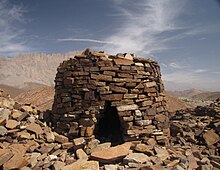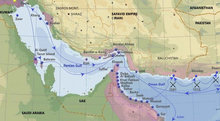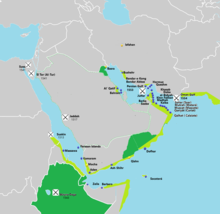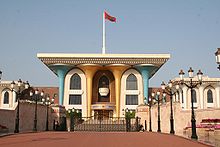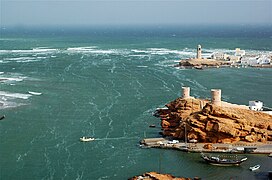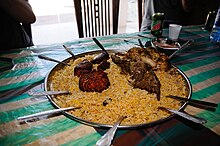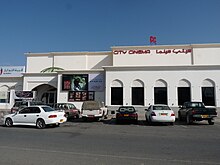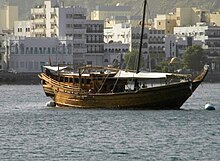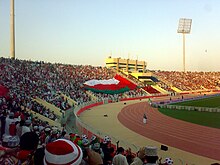Oman
Oman, officially the Sultanate of Oman (Arabic: سلطنة عُمان Sulṭanat ʻUmān), is a country located in western Asia, on the eastern coast of the Arabian Peninsula. It borders the United Arab Emirates to the northwest, Saudi Arabia to the west, and Yemen to the southwest. The coast is made up of the Arabian Sea to the south and east, and the Gulf of Oman to the northeast. It also has two enclaves, the Musandam peninsula, in the north of the United Arab Emirates, and Madha, in the east of the same country.[citation required]
Oman was founded as an Imamate in 751, making it the oldest state in the Arab world. Dating back to the 17th century was a major maritime power, coming into conflict with Portugal and the Netherlands over control of the Persian Gulf and the Indian Ocean. Omani influence or control extended across the Strait of Hormuz to Iran, and present-day Pakistan, as far south as Zanzibar. Their power declined during the century XIX and the sultanate came under British influence. Although Oman was never formally part of the British Empire, it did adopt protectorate status. Oman currently has strong military and political ties to the United Kingdom and the United States, although it maintains an independent foreign policy.
Oman is an absolute monarchy in which the Sultan of Oman exercises absolute authority, but its parliament has some legislative and supervisory powers. In November 2010, the United Nations Development Program named Oman, among 135 countries worldwide, as the country that had improved the most over the preceding 40 years. According to 2010 international indices, Oman is one of the most developed and stable countries in the Arab world.
Etymology
The exact origin of the country's name is unknown. Some of the oldest mentions of the region are Pliny the Elder's Omana and Ptolemy's Omanon (Όμανον εμπόριον), both they probably referred to the port of Sohar. contrary to the Bedouin), although other eponyms have also been proposed (Oman bin Ibrahim al-Khalil, Oman bin Siba' bin Yaghthan bin Ibrahim, Oman bin Qahtan, and the Biblical Lot). Still others think that it derives from a Yemeni valley with the same name, supposedly the origin of the country's founders.
History
The territory of Oman is mentioned on a tablet engraved on the sphinx in Gizeh, Egypt, around 1530 BC. C. Greek and Latin geographers (Ptolemy, Pliny) heard of the existence of this part of the Arabian peninsula. In the early III century, an Arab chieftain from Hira in Mesopotamia founded a kingdom in Oman that maintained its independence until the appearance of Islam (VII century century). Always linked to the history of Oman, Muscat was an important center from the VI century BCE. C., when the Sassanid Persians controlled the port. Omanis accepted Islam in the same VII century. Under the first caliphs, the country, far removed from the centers of power (either Mecca or Damascus), led an almost independent political existence, living off trade with the eastern African coast. The Omanis elected their first independent imam in 751, when the Umayyad Caliphate of Damascus fell and the Caliphate headquarters moved to Baghdad. Oman became a haven for Kharijite dissidents from the Baghdad caliphate. It was the Ibadi branch of the Khariji movement that prevailed in Oman in the 13th century. To this branch belonged the first dynasty of imams.
Portuguese
In 1507 the Portuguese were the first Europeans to arrive in Oman, and under the orders of Alburquerque they took the city of Muscat a year later.
A decade after Vasco da Gama's successful voyage around the Cape of Good Hope and into India in 1497-1498, the Portuguese arrived in Oman and occupied the region for a period of 143 years, from 1507 to 1650. They needed a Outpost to protect their maritime routes, the Portuguese built and fortified the cities and towns, where remains of their colonial architectural style still exist. An Ottoman fleet reportedly sacked Muscat in 1552, during the struggle for control of the Persian Gulf and the Indian Ocean. Several cities in Oman were colonized in the early 20th century XVI to control entries from the Persian Gulf and trade in the region. It was part of a network of fortresses that the Portuguese had in the region, from Basra to Hormuz. Several cities were drawn in the 17th century as it appears in António Bocarro's Book of the Fortress.
The Persian Gulf and the Gulf of Oman were the scene of some of the battles of the Ottoman-Portuguese conflicts during the 16th century.
Europeans and Omanis
The British, Dutch and Iranians were slow to respond to the Portuguese monopoly more than 140 years later, and in 1744 Imam Ahmad bin Said al-Busaidi, founder of the current dynasty, expelled the Iranians, who had occupied part of the coast.
At the end of the 18th century, the Omanis became a great naval and commercial power in the Indian Ocean. Between 1710 and 1855, years of the reign of Said Sultan, the Omanis dominated Zanzibar and part of the eastern African coast. The loss of Zanzibar, which declared itself independent in 1856, and European (German and British) intervention in East Africa eroded Oman's power. At the end of the XIX century, after a series of agreements, Great Britain installed a protectorate in Oman, leaving the reigning house in the throne.
In 1913 the rivalry between the imam of Oman and the sultan of Muscat sparked a rebellion in which the tribes of the interior supported the imam. Peace was restored in 1920 with the Sib treaty, and it lasted until 1954, when the imam's successor launched a new rebellion, this time supported by Egypt and Saudi Arabia. However, with the support of the British, the sultan's armies put an end to the rebellion in 1959. That conflict is known as the Jebel Akhdar War.
From 1964 to 1976, the very poor region of Dhofar was the scene of conflict between the sultan's army and a rebel movement. The rebellion made headway in the first few years and soon surrounded the city of Sallah, the main city in the region. Two congresses were held to define the political goals of the movement, in 1965 and 1968. During the second congress, the Dhofar Liberation Front became the Popular Front for the Liberation of Oman and the Arabian Gulf. The program adopted at these two congresses is tinged with communism. Its goal is to establish a "democratic peoples republic" and expel the British army from Oman. The Front is trying to establish a constitution, abolish martial law, restore freedom of the press and expression, and guarantee the rights of minorities. In economic matters, he intends to nationalize the oil companies, develop industries and implement agrarian reform. Therefore, the Front calls for more social justice and affirms its support for all liberation movements in Asia, Africa and Latin America. Reference is also made to the Palestinian struggle.
The Sultan's army cannot contain the advances of the Front, which has the support of a large part of the population. In 1970, despite the intervention of the British Royal Air Force, the insurgents controlled most of the strategic points in the region. Faced with this critical situation, the British decided to end the reign of Sultan Said, who was forced to abdicate in favor of his son Qabus ibn Said during a coup in July 1970. The new sovereign follows a policy of improving the socioeconomic conditions in his country and rebuilding his armed forces, aided by a sharp increase in state revenues after the 1973 oil crisis. With the support of the Iranian and British armies, the regime is gradually succeeding in subduing insurgency and mistreatment.
On 23 July 1970 the new Sultan Qabus ben Said changed the name of the nation to the Sultanate of Oman. In March 2016 archaeologists working off the coast of the island of Al Hallaniyah identified a shipwreck believed to be the Esmeralda of Vasco da Gama's fleet of 1502-1503. The wreck was initially discovered in 1998. Later, underwater excavations were carried out between 2013 and 2016 thanks to a collaboration between the Omani Ministry of Heritage and Culture and the British company Bluewater Recoveries Ltd. The vessel was identified through various artifacts such as a "Portuguese coin minted for trade with India" (currently only one other coin of the same type is known) and stone cannonballs engraved with what appears to be the initials of Vicente Sodré, Vasco da Gama's maternal uncle and commander of the Esmeralda. In recent years, Oman has had a close relationship with some Western states, most notably during the Gulf War and the 2003 invasion of Iraq.[citation needed]
In 2011, during the "Arab Spring," the protests took place in Oman in 2011.
In January 2021, it was revealed that the Sultanate of Oman had an heir for the first time in its history. Said designation fell on the figure of Sayid Theyazin bin Haizam, thirty years old.
Government and politics
The head of state and government is the sultan (Haitham bin Tariq Al Said), a hereditary ruler who chooses a cabinet that assists him. The functions of the sultan are those of an absolute monarch.
In the 1990s, however, the sultan instituted an elected advisory council, the Majlis ash-Shura', the 83-member lower house, of which a group of 190,000 citizens they could vote in 1997, and the sultan had veto or approval power. In 1996, the Upper House or the Majlis ad-Dawla, with 41 members, elected by the sultan, was established.[citation needed]
There is no constitution and justice is divided between the Supreme Court and the Islamic Traditional Courts.[citation needed] The Royal Oman Police, founded in 1974, It is the official police of the country.
Human Rights
In terms of human rights, regarding membership of the seven bodies of the International Bill of Human Rights, which include the Human Rights Committee (HRC), Oman has signed or ratified:
Political-administrative organization
Oman is divided into eleven governorates (muhafazat) as of October 28, 2011. Each of the governorates is divided into Valiats (wilayat).
| Governance |
|---|
|
Geography
Oman has an area of 309,500 km². It is located in the southeast of the Arabian Peninsula with a coastline of about 1,561 km in length and four natural regions: the coastal plain; a vast, flat desert that covers much of central Oman; the Dhofar, to the south, where the city of Salalah is located; and the mountain ranges on the north coast, whose highest peak is the Jabel Sham, with 3000 m altitude mountains that leave a flat strip on the north coast where the main cities of the country are located, Muscat (the capital), Matrah and South in the north, and in the south. Oman's climate in the interior is hot and dry, but on the coasts it is humid.[citation needed]
The Musandam peninsula, which has a strategic position on the Strait of Hormuz, is separated from the rest of the country by the United Arab Emirates. Not all of Oman's borders with that country are defined. Oman has an exclave within the UAE, the city of Madha. The sultanate is considered one of the fifteen states that are called the Cradle of Humanity.[citation needed]
Climate
Oman has a warm climate with very little rainfall. Average annual rainfall in Muscat is 100mm, falling mostly in January. The Dhofar region receives rain from June to September, as a result of winds from the Indian Ocean, cold humidity and dense fog. In the mountainous areas there is more precipitation, registering about 400 mm per year. In some sectors of the country's coast it does not rain for a whole year. The temperatures in general are very high, reaching 50 °C.
Ecology
The interior of Oman, to the west, is covered by the Rub al-Jali desert, one of the most inhospitable regions on the planet. This desert, along with the Wahiba sandbank, located further east, are part of the ecoregion called the Arabian-Sinai Xeric Desert and Forest. Towards the south coast, there is an ascending gradation of humidity, and it passes through the ecoregions called tropical desert and semi-desert of the Red Sea, piedmont savannah of southwestern Arabia and cloudy coastal desert of the Arabian peninsula. To the west, the biomes differ in altitude: the coast and low-lying areas are part of the desert and semi-desert of the Gulf of Oman, while in the mountains there is the wooded savannah of the Al Hajar Mountains.[citation required]
Economy
Just as Oman's history was always tied to Muscat, which is the main city, so was its economy. The lack of circulating coins in both territories as a consequence of the different revolts that took place during the years 1888 and 1913 forced Sheikh Faisal ben Turki to countermark pieces of eight Spanish reales, 5 French francs and Maria Teresa of Austria thalers in both sultanates to allow its circulation during that time. Both countermarks contained the legend "Oman and Muscat" in Arabic.
Oman currently has an economy based on the exploitation of large reserves of natural gas and oil. The system has been controlled by the ruling monarchy and members of the government. Starting in the year 2000, a liberalization process took place in a double sense: on the one hand, an attempt was made to separate economic and commercial activity from political power, typical of an absolutist system, and on the other, the orderly privatization of farms was facilitated. mining. The serious social imbalances still maintain a level of unemployment among the country's inhabitants of 15%, which has been falling over the last five years, with a progressive decrease in the workforce from countries such as Pakistan, Afghanistan or the India. At the same time, heavy industry for the transformation of products has increased, diversifying the economy.[citation needed]
Demographics
Oman is the easternmost Arab country. According to 2005 estimates, it had 3,001,583 inhabitants; most Omanis are Arabs, although there is a Baluchi minority. As in most Arab countries, a large number of foreign workers live there, mainly from India, Pakistan and Iran. The official language is Arabic, but minorities speak their own languages. A non-Arabic Semitic language is spoken in Dhofar.[citation needed] According to 2012 estimates, four urban agglomerations within Omani territory exceeded 130,000 residents. These were: the capital Muscat (1,318,799 inhabitants), Salalah (203,766), Sohar (132,702) and Suwayq (132,549).
Religion
The predominant religion is Islam, in its Ibadi form (this form which, among all the Islamic nations, is only dominant in the Sultanate of Oman and which is found in the branch of Kharijismo), with an important Sunni colony in Dhofar. The particular characteristics of Ibadism make Oman a much more tolerant and open nation than those of its surroundings, allowing the public practice of other religions (there are four Catholic parishes in Oman that belong to the Apostolic Vicariate of South Arabia). of jihadism and religious fundamentalism practically non-existent.
Omani's government does not keep statistics on religious affiliation, but nearly all Omanis are Muslims, most of whom follow the Ibadi School of Islam, followed by Twelver Shi'ite Islam and the Shafi school of Sunni Islam. Virtually all non-Muslims in Oman are foreign workers. Non-Muslim religious communities include various groups of Jains, Buddhists, Zoroastrians, Sikhs, Jews, Hindus, and Christians. Christian communities are centered in the main urban areas of Muscat, Sohar and Salalah. These include Catholic, Eastern Orthodox, and various Protestant congregations, which are organized along linguistic and ethnic lines. Over 50 different Christian groups, fellowships and assemblies are active in the greater Muscat area, made up of migrant workers from Southeast Asia.
There are also communities of Hindus and Christians of Indian ethnicity. Muscat has two Hindu temples. One of them is over a hundred years old. There is a significant Sikh community in Oman. Although there are no permanent gurdwaras, many smaller gurdwaras exist in makeshift camps and are recognized by the government. The Indian government signed an agreement in 2008 with the Omani government to build a permanent gurdwara, but little progress has been made on this matter.
Percentages: Ibadi Muslims 75%, Sunni and Shia Muslims 10%, Christians 8.7%, Hindus 5.5%, Buddhists 0.8%.
Culture
Although Oman is a modern country, Western influences are restrained; The Ibadi form of Islam is very strict compared to the Jiite and Sunni forms.[citation needed]
Clothing
For males, the national dress consists of a long, knee-length, collarless tunic with long sleeves called a dishdasha. Apart from the tunic, men use other accessories such as the muzzar (a type of turban), the assa (a staff used mainly for formal occasions) and the khanjar. , a ceremonial curved dagger often considered an important symbol of masculine elegance. Omani women's clothing consists of a long dress worn over trousers (sirwal) and a headscarf (lihaf). The design of the dress varies depending on the regions, as well as the color and materials. Women's clothing is complemented by jewelry, cosmetics, and handcrafted ornaments.
Gastronomy
Omani cuisine is generally very simple, seasoned with many spices to complete the dishes, which usually consist of chicken, fish and lamb, which vary from region to region. In general, the dishes are accompanied by rice, a wide variety of soups and broths, salads, curries and fresh vegetables. In the desert, many Omanis eat a sweet called halwa. It is normally served before the consumption of kahwa, a very popular type of coffee that is considered a symbol of hospitality. Other popular drinks are laban (a kind of salty butter) and liquid yoghurts. For the festivities special dishes are prepared, following Islamic traditions. The gastronomic diversity of these occasions is very diverse, although they are only prepared on these occasions.
Cinema
Opened in 2001, the Muscat International Film Festival was the first film festival in the Persian Gulf region. Since then it has been held every two years in the country's capital. Most of the films screened in Oman are American (Hollywood) and Indian (Bollywood) films, and local production is very modest. In 2006 Khalid Al Zedjali directed Al Boom the first Omani feature film.
Parties
| Date | Name in Spanish | Local name |
|---|---|---|
| Muslim calendar | ||
| 1 Muharram | New Muslim Year | Awal Muharram |
| 12 Rabi al Awal | Birth of the Prophet Muhammad | Al Mawlid Annawabi Asharif |
| 17 of Rajab | Ascension of the Prophet Muhammad | Al Isra'a wa'l Mi'raj |
| 1 Shawal | End of Ramadan | Id el-Fitr |
| 10 Dhou al Hidjia | End of the pilgrimage to La Meca | |
| Gregorian Calendar | ||
| 1 January | New Year | |
| 23 July | Day of rebirth* | |
| 18 November | National Day | |
| 19 November | Birthdays of Sultan Qaboos bin Said** | |
| (*)= Ascension to the power of Sultan Qaboos bin Said in 1970 (**)= Born on 18 November 1940 | ||
Sports
In October 2004, the Omani government established a Ministry of Sports Affairs to replace the General Organization for Youth, Sports and Cultural Affairs. The XIX Arabian Gulf Cup was held in Muscat from January 4 to 17, 2009 and was won by the Oman national football team. The 23rd Arabian Gulf Cup which took place in Kuwait, from December 22, 2017 to January 5, 2018, with Oman winning their second title, defeating the United Arab Emirates in the final on penalties after a goalless draw.
The first "Clásico" played outside of Spain it was played on March 14, 2014 at the Sultan Qaboos Sports Complex. Real Madrid F.C. It started with a team of eleven players: Contreras, Míchel Salgado, Pavón, Belenguer, Fernando Sanz, Velasco, Fernando Hierro, De la Red, Amavisca, Sabido and Alfonso. Emilio Álvarez, García Cortés, Torres Mestre, Morán, Álex Pérez and Iván Pérez also played. FC Barcelona played with: Felip, Coco, Roberto, Nadal, Goicochea, Milla, Víctor Muñoz, Gaizka Mendieta, Giuly, Ezquerro and Luis García. Moner, Ramos, Albert Tomás, Mulero, Arpón, Lozano and Christiansen also played. The match ended with a score of 2 to 1 in favor of FC Barcelona.
Contenido relacionado
Warrior status
Simple conical projection
Silesia
